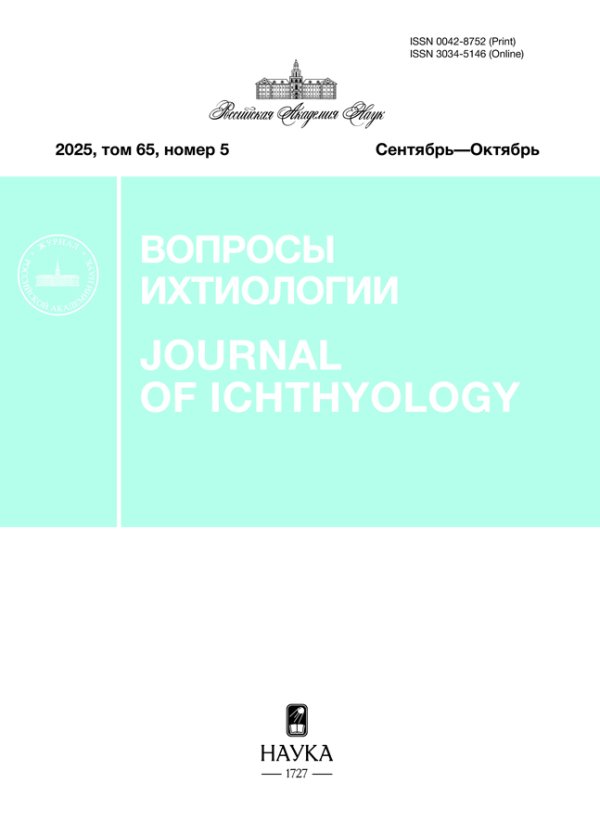Structure of Aggressive Behavior in Underyearlings of the Rainbow Trout Oncorhynchus mykiss (Salmonidae) Changes under the Influence of Diplostomum pseudospathaceum (Trematoda) Parasites
- Authors: Mikheev V.N.1, Pasternak A.F.2
-
Affiliations:
- Severtsov Institute of Ecology and Evolution, Russian Academy of Sciences, Moscow, Russia
- Shirshov Institute of Oceanology, Russian Academy of Sciences, Moscow, Russia
- Issue: Vol 63, No 4 (2023)
- Pages: 472-477
- Section: Articles
- URL: https://journals.rcsi.science/0042-8752/article/view/135217
- DOI: https://doi.org/10.31857/S0042875223040203
- EDN: https://elibrary.ru/ROEVVP
- ID: 135217
Cite item
Full Text
Abstract
The dynamics of aggressive behavior of the underyearlings of the rainbow trout Oncorhynchus mykiss infected with metacercariae of the trematodes Diplostomum pseudospathaceum has been studied in an experimental heterogeneous environment for 48 days. The fish competed for the dark area of the bottom by charges, biting, chasing, and frontal and lateral displays. The sharply increased aggressiveness of fish when the parasites became infective (1.0–1.5 months after infection), i.e., capable of infecting the final host (piscivorous birds), manifested itself in an increased frequency of bites (more than 20 times compared to the control) and charges (almost three times) and was accompanied by fast movements, sharp maneuvers, and low ability to compete for shelters. The share of comparatively slow displays and chasing was much smaller. The strategy of D. pseudospathaceum manipulation of fish behavior consists of two stages: (1) protecting the host from predators; (2) increasing the vulnerability of the host. At the first stage, the general level of aggression decreases sharply; at the second, on the contrary, aggressiveness rapidly increases, but the ratio of different categories of aggression changes. The share of categories that make the host more vulnerable to predators increases. High activity and low competitiveness of infected fish contribute to their rapid extermination by predators or moving to another habitat. Such migration of fish can increase the fitness of the parasite, facilitating its dispersal in the water body.
About the authors
V. N. Mikheev
Severtsov Institute of Ecology and Evolution, Russian Academy of Sciences, Moscow, Russia
Email: vicnikmik@gmail.com
Россия, Москва
A. F. Pasternak
Shirshov Institute of Oceanology, Russian Academy of Sciences, Moscow, Russia
Author for correspondence.
Email: vicnikmik@gmail.com
Россия, Москва
References
- Михеев В.Н. 2006. Неоднородность среды и трофические отношения у рыб. М.: Наука, 191 с.
- Сливко В.М., Жохов А.Е., Гопко М.В., Михеев В.Н. 2021. Агонистическое поведение молоди окуня Perca fluviatilis: влияние размеров рыб и заражённости макропаразитами // Вопр. ихтиологии. Т. 61. № 3. С. 356–361. https://doi.org/10.31857/S0042875221030164
- Шигин А.А. 1986. Трематоды фауны СССР. Род Diplostomum. Метацеркарии. М.: Наука, 253 с.
- Arnott G., Elwood R.W. 2009. Assessment of fighting ability in animal contests // Anim. Behav. V. 77. № 5. P. 991–1004. https://doi.org/10.1016/j.anbehav.2009.02.010
- Barber I., Hoare D., Krause J. 2000. Effects of parasites on fish behaviour: a review and evolutionary perspective // Rev. Fish Biol. Fish. V. 10. № 2. P. 131–165. https://doi.org/10.1023/A:1016658224470
- Crowden A.E., Broom D.M. 1980. Effects of eyefluke, Diplostomum spathaceum, on the behaviour of dace (Leuciscus leuciscus) // Anim. Behav. V. 28. № 1. P. 287–294. https://doi.org/10.1016/S0003-3472(80)80031-5
- Cutts C., Metcalfe N.B., Taylor A.C. 1998. Aggression and growth depression in juvenile Atlantic salmon: the consequences of individual variation in standard metabolic rate // J. Fish Biol. V. 52. № 5. P. 1026–1037. https://doi.org/10.1111/j.1095-8649.1998.tb00601.x
- Dianne L., Perrot-Minnot M-J., Bauer A. et al. 2011. Protection first then facilitation: a manipulative parasite modulates the vulnerability to predation of its intermediate host according to its own developmental stage // Evolution. V. 65. № 9. P. 2692–2698. https://doi.org/10.1111/j.1558-5646.2011.01330.x
- Earley R.L., Hsu Y. 2013. Contest behaviour in fishes // Animal contests. Cambridge: Cambridge Univ. Press. P. 199–227. https://doi.org/10.1017/CBO9781139051248.012
- Grant J.W.A. 1997. Territoriality // Behavioural ecology of teleost fishes. Oxford: Oxford Univ. Press. P. 81–103.
- Grant J.W.A., Noakes D.L.G. 1987. Movers and stayers: Foraging tactics of young-of-the-year brook charr, Salvelinus fontinalis // J. Anim. Ecol. V. 56. № 3. P. 1001–1013. https://doi.org/10.2307/4962
- Grantner A., Taborsky M. 1998. The metabolic rates associated with resting, and with the performance of agonistic, submissive and digging behaviours in the cichlid fish Neolamprologus pulcher (Pisces: Cichlidae) // J. Comp. Physiol. B. V. 168. № 6. P. 427–433. https://doi.org/10.1007/s003600050162
- Huntingford F.A., Turner A.K. 1987. Animal conflict. London: Chapman and Hall, 448 p. https://doi.org/10.1007/978-94-009-3145-9
- Kalleberg V. 1958. Observations in a stream tank of territoriality and competition in juvenile salmon and trout (Salmo salar L. and S. trutta L.) // Rep. Inst. Freshw. Res., Drottingholm. V. 39. P. 55–98.
- Katano O., Iguchi K. 1996. Individual differences in territory and growth of ayu, Plecoglossus altivelis (Osmeridae) // Can. J. Zool. V. 74. № 12. P. 2170–2177. https://doi.org/10.1139/z96-245
- Keenleyside M.H.A., Yamamoto F.T. 1962. Territorial behaviour of juvenile Atlantic salmon (Salmo salar L.) // Behaviour. V. 19. № 1–2. P. 139–168. https://doi.org/10.1163/156853961X00231
- Lafferty K.D. 1999. The evolution of trophic transmission // Parasitol. Today. V. 15. № 3. P. 111–115. https://doi.org/10.1016/S0169-4758(99)01397-6
- Landeau L., Terborgh J. 1986. Oddity and the “confusion effect” in predation // Anim. Behav. V. 34. № 5. P. 1372–1380. https://doi.org/10.1016/S0003-3472(86)80208-1
- Metcalfe N.B. 1986. Intraspecific variation in competitive ability and food intake in salmonids: consequences for energy budgets and growth rates // J. Fish Biol. V. 28. № 5. P. 525–531. https://doi.org/10.1111/j.1095-8649.1986.tb05190.x
- Mikheev V.N., Adams C.E., Huntingford F.A., Thorpe J.E. 1996. Behavioural responses of benthic and pelagic Arctic charr to substratum heterogeneity // Ibid. V. 49. № 2. P. 494–500. https://doi.org/10.1111/j.1095-8649.1996.tb00044.x
- Mikheev V.N., Pasternak A.F., Tischler G., Wanzenböck J. 2005. Contestable shelters provoke aggression among 0+ perch, Perca fluviatilis // Environ. Biol. Fish. V. 73. № 2. P. 227–231. https://doi.org/10.1007/s10641-005-0558-8
- Mikheev V.N., Pasternak A.F., Taskinen J., Valtonen E.T. 2010. Parasite-induced aggression and impaired contest ability in a fish host // Parasites Vectors. V. 3. Article 17. https://doi.org/10.1186/1756-3305-3-17
- Moore J. 1995. The behaviour of parasitized animals // BioScience. V. 45. P. 89–96. https://doi.org/10.2307/1312610
- Moyer K.E. 1968. Kinds of aggression and their physiological basis // Commun. Behav. Biol. Pt. A. V. 2. № 2. P. 65–87.
- Noleto-Filho E.M., dos Santos Gauy A.C., Pennino M.G., Goncalves-de-Freitas E. 2017. Bayesian analysis improves experimental studies about temporal patterning of aggressive fish // Behav. Proc. V. 145. P. 18–26. https://doi.org/10.1016/j.beproc.2017.09.017
- Parker G.A., Ball M.A., Chubb J.C. et al. 2009. When should a trophically transmitted parasite manipulate its host? // Evolution. V. 63. № 2. P. 448–458. https://doi.org/10.1111/j.1558-5646.2008.00565.x
- Poulin R. 2010. Parasite manipulation of host behaviour: an update and frequently asked questions // Adv. Stud. Behav. V. 41. P. 151–186. https://doi.org/10.1016/S0065-3454(10)41005-0
- Seppälä O., Karvonen A., Valtonen E.T. 2005a. Impaired crypsis of fish infected with a trophically transmitted parasite // Anim. Behav. V. 70. № 4. P. 895–900. https://doi.org/10.1016/j.anbehav.2005.01.021
- Seppälä O., Karvonen A., Valtonen E.T. 2005b. Manipulation of fish host by eye flukes in relation to cataract formation and parasite infectivity // Ibid. V. 70. № 4. P. 889–894. https://doi.org/10.1016/j.anbehav.2005.01.020
- Sweeting R. 1974. Investigations into natural and experimental infections of freshwater fish by the common eye-fluke Diplostomum spathaceum Rud. // Parasitology. V. 69. № 3. P. 291–300. https://doi.org/10.1017/s0031182000062995
- Vøllestad L.A., Quinn T.P. 2003. Trade-off between growth rate and aggression in juvenile coho salmon, Oncorhynchus kisutch // Anim. Behav. V. 66. № 3. P. 561–568. https://doi.org/10.1006/anbe.2003.2237
- Voutilainen A., Taskinen J., Huuskonen H. 2010. Temperature-dependent effect of the trematode eye flukes Diplostomum spp. on the growth of Arctic charr Salvelinus alpinus (L.) // Bull. Eur. Ass. Fish Pathol. V. 30. № 3. P. 106–113.
- Weinreich F., Benesh D.P., Milinski M. 2013. Suppression of predation on the intermediate host by two trophically-transmitted parasites when uninfective // Parasitology. V. 140. № 1. P. 129–135. https://doi.org/10.1017/S0031182012001266
Supplementary files













